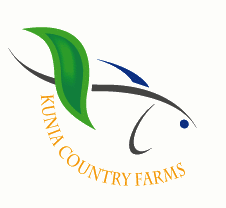
KUNIA COUNTRY FARMS


Sustainable Agriculture and Aquaponics in Hawaii
AQUAPONICS is a blend of aquaculture and hydroponics. Simply put, the fish in our system naturally provide nutrients for the plants to grow, and the plants in the system act as a biological filter to clean the water returning to the fish.
AQUAPONICS
OUR AQUAPONIC SYSTEM
Kunia Country Farms operates a deep water culture (DWC) or raft aquaponic system. We currently have 20 grow bed troughs built on a 1 acre field. Each trough measures 96 feet long by 8 feet wide, for a total growing area of 768 square feet per trough and 13,800 square feet for the entire system. The term "deep water" can be a bit misleading, there is only 10-12 inches of water depth in each trough. This is sufficient for the root system of plants like lettuce. Each trough can grow from 1,650 to 3,300 plants, depending on optimal spacing for the specific varieties.
The basic system setup is shown on a diagram (click "schematic" below). In essence, this is a giant recirculating fish tank with the filtered water diverted to growing troughs before it returns to the fish. The Tilapia provide nutrient rich water to the plants in the troughs, and the plants act as an additional biological filter to return clean water to the fish. When the system is in balance, both the fish and the plants benefit from this relationship. The only necessary inputs for our system are the fish feed, plant seeds, and occasional iron, calcium, and potassium.

AQUACULTURE
Kunia Country Farms currently has six fish tanks with two more under construction. Each of our tanks, twelve feet in diameter and 4 feet tall, hold hormone-free, FNO-free Tilapia nourishing our system of grow troughs.
Our Tilapia breeding tank is "green water" and off-system to protect the water quality in our troughs.

HYDROPONICS
Hydroponics is a water-based soilless growing technology. Water is fed to the plant root system either by constant drip (thin film), gravel bed ebb-and-flow, or deep water culture (raft) ponics. Generally, hydroponics requires adding the various nutrient components directly to the water supply. On one hand this might seem more like chemistry than farming, on the other hand this gives complete control over the nutrient profile of the water. No guesswork.
Aquaponics adds a layer of complexity because you also have to balance the aquatic ecosystem as well. The main benefit is the symbiotic relationship between the fish and plants. The main drawback is the difficulty in balancing the compromise ecosystem where both organisms are able to thrive.
